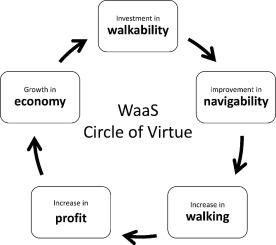Transportation Research Part A: Policy and Practice ( IF 6.4 ) Pub Date : 2020-05-30 , DOI: 10.1016/j.tra.2020.05.015 Glenn Lyons

|
Amidst the hype and prospects offered by technological innovation for shaping the future of mobility, it can be easy to overlook the humble and enduring place and potential of walking as a means of movement in our mobility system. Yet walking may already be part of the change taking place, as technological innovation and behaviour come together. This paper considers the potential significance of pedestrian navigation that has been placed in the hands of smartphone users, referring to it as ‘Walking as a Service’ (WaaS).
For individuals physically able to, walking can provide a number of positive attributes including independence, reliability, flexibility, exercise and affordability. Such attributes may compare favourably with other means of transport for shorter journeys. Yet in spite of this it is often not the mode of choice. One of its limitations can be the cognitive challenge – when faced with the unfamiliar - of judging how long a journey could take on foot and determining how to navigate to the destination. Google Maps Navigation now addresses this with what appears to be ever improving attention to usability. Audio-visual assistance ‘holds your hand’ on your journey and keeps track of how far you have left to go and the estimated time needed. With a focus on the UK, the paper explores the prospects for, and place of, WaaS in the future of mobility, also highlighting an apparent sharp increase in average walking trip rate from 2015 to 2018. It draws out a distinction between the business model of Mobility as a Service (MaaS - which sells access to mobility) and that of WaaS (which sells access to geography and consumers) and puts forward the WaaS Circle of Virtue wherein WaaS is able to support sustainability and profitability.
中文翻译:

步行即服务–它有腿吗?
在技术创新为塑造出行方式的未来所提供的炒作和前景之中,很容易忽略了不起眼,经久不衰的地方以及步行作为我们出行系统中一种出行方式的潜力。然而,随着技术创新和行为融合在一起,步行可能已经成为变革的一部分。本文考虑了智能手机用户手中行人导航的潜在重要性,称其为“步行即服务”(WaaS)。
对于有身体能力的人,步行可以提供许多积极属性,包括独立性,可靠性,灵活性,运动能力和承受能力。对于较短的旅程,这些属性可以与其他交通工具相比。尽管如此,它通常不是选择的方式。它的局限性之一可能是认知上的挑战-当面对陌生时-判断旅途可能需要走多长时间并确定如何导航到目的地。Google Maps Navigation现在通过似乎不断提高对可用性的关注来解决此问题。视听协助“牵手”您的旅程,并跟踪您还有多远和估计的时间。本文以英国为重点,探讨了WaaS在移动交通未来的前景和地位,和盈利能力。


























 京公网安备 11010802027423号
京公网安备 11010802027423号